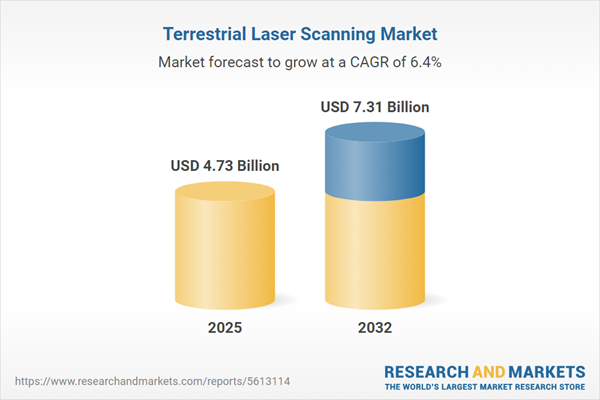Speak directly to the analyst to clarify any post sales queries you may have.
Terrestrial laser scanning is reshaping enterprise asset management by providing accurate and actionable 3D data. Senior decision-makers leverage these solutions to improve project execution, enhance compliance, and future-proof their organizations against risk, positioning them to adapt in a rapidly digitalizing business landscape.
Market Snapshot: Growth and Dynamics in the Terrestrial Laser Scanning Market
The terrestrial laser scanning market is experiencing steady expansion as more industries accelerate adoption of digital modeling and precision asset management. Valued at USD 4.44 billion globally in 2024, the sector is set to reach USD 4.73 billion in 2025 and USD 7.31 billion by 2032. Core growth drivers include the increased need for operational efficiency and regulatory compliance within construction, automotive, infrastructure, and cultural heritage segments. Companies are moving rapidly from manual systems to end-to-end digitalization, intensifying demand for solutions that ensure project speed, security, and sustainable risk reduction. 3D scanning-driven representations offer businesses a powerful way to optimize decisions in challenging and regulated environments.
Scope & Segmentation: Comprehensive Terrestrial Laser Scanning Market Overview
- Product Types: Mobile and static terrestrial laser scanning systems offer adaptability for work at complex, remote, or restricted sites, addressing a wide range of operational needs and field conditions.
- Components: The market spans hardware, software, consulting, and maintenance services, enabling enterprises to implement tailored, integrated solutions customized around distinct asset management strategies.
- Technology Types: Solutions use phase shift, time of flight, and triangulation technologies, providing high levels of data accuracy and streamlining detailed project verification without manual intervention.
- Applications: Principal applications include automotive manufacturing, building information modeling, cultural documentation, mapping of utility infrastructure, mining operations, and geospatial surveying; each sector sees gains in accuracy, efficiency, and safety.
- End Use Industries: Aerospace, defense, transportation, energy, utilities, and construction leverage terrestrial laser scanning to drive digital oversight and evolve operational practices.
- Geographic Regions: Americas lead with infrastructure upgrades, Europe invests in heritage assets and regulatory compliance, Asia-Pacific funds smart city projects, and the Middle East & Africa adapt scanning for varied infrastructure demands.
- Key Companies: Leading providers are Leica Geosystems AG, Trimble Inc., FARO Technologies Inc., Topcon Corporation, Riegl Laser Measurement Systems GmbH, Teledyne Technologies Inc., NavVis GmbH, GeoSLAM Limited, Shining 3D Tech Co. Ltd., and Zoller + Fröhlich GmbH.
Segment-specific developments enable executives to spot growth opportunities and adapt capital strategies by benchmarking against a dynamic competitive set.
Key Takeaways: Strategic Insights for Technology Leadership
- Terrestrial laser scanning lets organizations shift from reactive asset management to predictive planning, strengthening asset reliability and sustaining long-term operational value.
- The scalability of these systems supports deployment in urban centers or logistically complex locations, delivering trustworthy data for decision-making in diverse scenarios.
- Integration with enterprise platforms fosters comprehensive data visibility, supporting improved analytics and more effective capital and resource planning.
- Flexible access to modular hardware, robust software, and advisory services accelerates onboarding timelines and empowers organizations to refine their setups as priorities evolve.
- Regional adoption patterns reflect local priorities, with European markets emphasizing compliance, Americas focusing on infrastructure, and Asia-Pacific channeling investment into smart urbanization initiatives.
Tariff Impact: Navigating U.S. Trade Policy Changes
Recent U.S. trade tariff adjustments have driven suppliers to scale local manufacturing and bolster supply chain resilience. In response, enterprises are digitizing customs management and improving logistics flexibility to sustain business continuity as policy shifts continue.
Methodology & Data Sources: Ensuring Robust Market Intelligence
Market findings rely on expert interviews, detailed analysis of corporate disclosures, regulatory reviews, and broad sector studies. The strategies and recommendations presented have been validated across these authoritative sources to provide reliable and actionable insights.
Why This Report Matters: Executive-Level Insights
- Gain a holistic understanding of terrestrial laser scanning adoption patterns, use cases, and regional market dynamics critical for executive decisions.
- Access current best practices for supply chain strategy and compliance, equipping organizations to sustain operations amid evolving regulations and competition.
- Apply segmentation and benchmarking intelligence to allocate capital effectively and drive digital transformation at scale.
Conclusion
Terrestrial laser scanning continues to advance asset transparency and operational control, supporting vital sectors through change. This report provides senior leaders with essential intelligence to implement resilient and forward-looking market strategies.
Additional Product Information:
- Purchase of this report includes 1 year online access with quarterly updates.
- This report can be updated on request. Please contact our Customer Experience team using the Ask a Question widget on our website.
Table of Contents
3. Executive Summary
4. Market Overview
7. Cumulative Impact of Artificial Intelligence 2025
Companies Mentioned
The companies profiled in this Terrestrial Laser Scanning market report include:- Leica Geosystems AG
- Trimble Inc.
- FARO Technologies, Inc.
- Topcon Corporation
- Riegl Laser Measurement Systems GmbH
- Teledyne Technologies, Inc.
- NavVis GmbH
- GeoSLAM Limited
- Shining 3D Tech Co., Ltd.
- Zoller + Fröhlich GmbH
Table Information
| Report Attribute | Details |
|---|---|
| No. of Pages | 199 |
| Published | October 2025 |
| Forecast Period | 2025 - 2032 |
| Estimated Market Value ( USD | $ 4.73 Billion |
| Forecasted Market Value ( USD | $ 7.31 Billion |
| Compound Annual Growth Rate | 6.4% |
| Regions Covered | Global |
| No. of Companies Mentioned | 11 |









